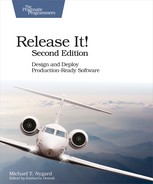Aiming for Quality Assurance
To understand why the site crashed so badly, so quickly, we must take a brief look back at the three years leading up to that point.
It’s rare to see such a greenfield project, for a number of good reasons. For starters, there’s no such thing as a website project. Every one is really an enterprise integration project with an HTML interface. Most are an API layer over the top of back-end services. This project was in the heyday of the monolithic “web site” on a commerce suite. It did 100 percent server-side rendering.
When the back end is being developed along with the front end, you might think the result would be a cleaner, better, tighter integration. It’s possible that could happen, but it doesn’t come automatically; it depends on Conway’s law. The more common result is that both sides of the integration end up aiming at a moving target.
Replacing the entire commerce stack at once also brings a significant amount of technical risk. If the system is not built with stability patterns, it probably follows a typical tightly coupled architecture. In such a system, the overall probability of system failure is the joint probability that any one component fails.
Even if the system is built with the stability patterns (this one wasn’t), a completely new stack means that nobody can be sure how it’ll run in production. Capacity, stability, control, and adaptability are all giant question marks.
Early in my time on the project, I realized that the development teams were building everything to pass testing, not to run in production. Across the fifteen applications and more than five hundred integration points, every single configuration file was written for the integration-testing environment. Hostnames, port numbers, database passwords: all were scattered across thousands of configuration files. Worse yet, some of the components in the applications assumed the QA topology, which we knew would not match the production environment. For example, production would have additional firewalls not present in QA. (This is a common “penny-wise, pound-foolish” decision that saves a few thousand dollars on network gear but costs more in downtime and failed deployments.) Furthermore, in QA, some applications had just one instance that would have several clustered instances in production. In many ways, the testing environment also reflected outdated ideas about the system architecture that everyone “just knew” would be different in production. The barrier to change in the test environment was high enough, however, that most of the development team chose to ignore the discrepancies rather than lose one or two weeks of their daily build-deploy-test cycles.
When I started asking about production configurations, I thought it was just a problem of finding the person or people who had already figured these issues out. I asked the question, “What source control repository are the production configurations checked into?” and “Who can tell me what properties need to be overridden in production?”
Sometimes when you ask questions but don’t get answers, it means nobody knows the answers. At other times, though, it means nobody wants to be seen answering the questions. On this project, it was some of both. And sometimes when you ask too many questions, you get tagged to answer them.
I decided to compile a list of properties that looked as if they might need to change for production: hostnames, port numbers, URLs, database connection parameters, log file locations, and so on. Then I hounded developers for answers. A property named “host” is ambiguous, especially when the host in QA has five applications on it. It could mean “my own hostname,” it could mean “the host that is allowed to call me,” or it could mean “the host I use to launder money.” Before I could figure out what it should be in production, I had to know which it was.
Once I had a map of which properties needed to change in production, it was time to start defining the production deployment structure. Thousands of files would need changes to run in production. All of them would be overwritten with each new software release. The idea of manually editing thousands of files, in the middle of the night, for each new release was a nonstarter. In addition, some properties were repeated many, many times. Just changing a database password looked as if it would necessitate editing more than a hundred files across twenty servers, and that problem would only get worse as the site grew.
Faced with an intractable problem, I did what any good developer does: I added a level of indirection. (Even though I was in operations, I had been a developer most of my career so I still tended to approach problems with that perspective.) The key was to create a structure of overrides that would remain separate from the application codebase. The overrides would be structured such that each property that varied from one environment to the next existed in exactly one place. Then each new release could be deployed without overwriting the production configuration. These overrides also had the benefit of keeping production database passwords out of the QA environment (which developers could access) and out of the source control system (which anyone in the company could access), thereby protecting our customers’ privacy.
In setting up the production environment, I had inadvertently volunteered to assist with the load test.
